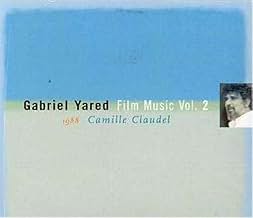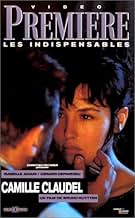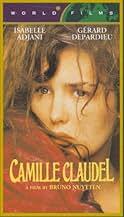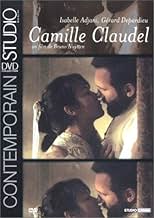VALUTAZIONE IMDb
7,3/10
7742
LA TUA VALUTAZIONE
Camille Claude fa colpo sul già famoso scultore Auguste Rodin. La assume come assistente, ma presto Camille inizia a scolpire per se stessa e diventa anche la sua amante. Ma dopo un po', vor... Leggi tuttoCamille Claude fa colpo sul già famoso scultore Auguste Rodin. La assume come assistente, ma presto Camille inizia a scolpire per se stessa e diventa anche la sua amante. Ma dopo un po', vorrebbe uscire dalla sua ombra.Camille Claude fa colpo sul già famoso scultore Auguste Rodin. La assume come assistente, ma presto Camille inizia a scolpire per se stessa e diventa anche la sua amante. Ma dopo un po', vorrebbe uscire dalla sua ombra.
- Regia
- Sceneggiatura
- Star
- Candidato a 2 Oscar
- 7 vittorie e 14 candidature totali
Recensioni in evidenza
I couldn't take my eyes away from the television, and it wasn't because it was in French with English subtitles. This is a superbly acted film depicting two artists' work, passion, fears and ultimately her downfall, falling victim to her own creative mind.
Now that this wonderful story will be a Broadway musical in 2003 under the finesse of Frank Wildhorn and the magical voice of lovely Linda Eder, one will certainly appreciate familiarizing themselves with the background of the subject of this movie, Camille Claudel.
Now that this wonderful story will be a Broadway musical in 2003 under the finesse of Frank Wildhorn and the magical voice of lovely Linda Eder, one will certainly appreciate familiarizing themselves with the background of the subject of this movie, Camille Claudel.
This is an excellent film and I highly recommend it. The imagery and soundtrack is lush, and the story focuses intensely on Camille's perfectionism and fortitude, all the while depicting her descent into madness, although some claim she wasn't mad, merely a woman ahead of her time, and thus ostracized.
From what I have read of various biographies of Camille Claudel, I understand that she was a woman ahead of her time; she scorned the bourgeois, just as many artists, writer, and musicians did -- in the same way that modern artists scorn the common, small-minded, and narrow society (read Hermann Hesse's Steppenwolf for a good understanding of the artist's situation in society).
Following the pattern of Vincent van Gogh and Franz Schubert, Camille Claudel was not a great "promoter" of her works, and, to make things worse, the bourgeois society, just like today, failed to understand her art (again, like the plight of Vincent van Gogh and many others).
At her core, Camille Claudel was a true rebel, not because she wanted to be, but because she had to. Camille Claudel was a true artist, in the very deepest sense.
From what I have read of various biographies of Camille Claudel, I understand that she was a woman ahead of her time; she scorned the bourgeois, just as many artists, writer, and musicians did -- in the same way that modern artists scorn the common, small-minded, and narrow society (read Hermann Hesse's Steppenwolf for a good understanding of the artist's situation in society).
Following the pattern of Vincent van Gogh and Franz Schubert, Camille Claudel was not a great "promoter" of her works, and, to make things worse, the bourgeois society, just like today, failed to understand her art (again, like the plight of Vincent van Gogh and many others).
At her core, Camille Claudel was a true rebel, not because she wanted to be, but because she had to. Camille Claudel was a true artist, in the very deepest sense.
In the realm of art and cinema, there are tales of triumph, stories of struggle, and then there is the heart-wrenching saga of Camille Claudel, masterfully portrayed in Bruno Nuytten's film. This cinematic masterpiece delves into the life of the 19th-century French sculptor Camille Claudel, bringing her intricate story to life with unparalleled grace and depth. It's a tale of passion, creativity, madness, and societal restraint, told through the lens of Camille's artistry.
Camille Claudel, portrayed by the brilliant Isabelle Adjani, was a remarkable sculptor. The film showcases her life journey, from her upbringing in the small village of Villeneuve-sur-Fère to her artistic blossoming in Paris under the guidance of none other than the renowned Auguste Rodin. Their encounter, a passionate rendezvous between student and master, ignites a profound and turbulent love affair.
The film captures the beauty of Camille's artistry as her hands meticulously shape exquisite works of art. Her sculptures are a testament to her modernity, audacity, and unwavering dedication to the craft. They reflect the struggles, the passions, and the relentless pursuit of her artistry, providing glimpses into her inner world. While Camille's works are captivating, her relationship with Rodin brings both admiration and scorn. Their union is a blend of student-mentor dynamics, artistic collaboration, and intense romantic involvement, leading to unrelenting societal judgment.
Yet, Camille is not solely defined by her artistic genius. Her life is marked by isolation, frustration, and the anguish of an unrequited love, intensified by Rodin's continued relationship with Rose Beuret. She becomes an artist alone, adrift in the sea of her emotions. Her world is a whirlpool of despair, loneliness, and financial struggle, interspersed with visions and obsessions that haunt her.
Camille's family disapproves of her lifestyle and choices, and the art world misunderstands her uniqueness. Her mother despises her perceived recklessness, her brother Paul harbors jealousy for her extraordinary talent, and her sister Louise schemes to claim Camille's inheritance. In the face of relentless adversity, Camille is committed to her artistic expression and personal journey.
Despite her distance from Rodin, he continues to support her with discreet acts of kindness. He writes letters to secure precious materials for her work, and he introduces her to influential art critics. However, these critics view her art as unconventional, mirroring her uniqueness and inner turmoil.
Camille Claudel, the artist par excellence, lived a life of wealth, beauty, determination, and promise in her youth. Still, her brilliance was overshadowed by the tragedy of her later years. She was left unrecognized, locked away in isolation, where her art became both her refuge and her torment. It was here, within the confines of her solitude, that she chose to destroy many of her own creations.
Camille's story is a testament to a life of artistry and heartache, unacknowledged talent, and the agony of unrealized dreams. Her impact on the art world was long overdue for recognition. Almost a century later, in 1988, her life's narrative was finally shared with the world through Bruno Nuytten's film, marking a turning point in the rediscovery of her art and her enduring legacy. The Musée Camille Claudel, opened in 2017 in Nogent-sur-Seine, France, stands as a national museum, dedicated to preserving and celebrating her art, ensuring that Camille Claudel's work rightfully finds its place in the annals of art history.
Camille Claudel, portrayed by the brilliant Isabelle Adjani, was a remarkable sculptor. The film showcases her life journey, from her upbringing in the small village of Villeneuve-sur-Fère to her artistic blossoming in Paris under the guidance of none other than the renowned Auguste Rodin. Their encounter, a passionate rendezvous between student and master, ignites a profound and turbulent love affair.
The film captures the beauty of Camille's artistry as her hands meticulously shape exquisite works of art. Her sculptures are a testament to her modernity, audacity, and unwavering dedication to the craft. They reflect the struggles, the passions, and the relentless pursuit of her artistry, providing glimpses into her inner world. While Camille's works are captivating, her relationship with Rodin brings both admiration and scorn. Their union is a blend of student-mentor dynamics, artistic collaboration, and intense romantic involvement, leading to unrelenting societal judgment.
Yet, Camille is not solely defined by her artistic genius. Her life is marked by isolation, frustration, and the anguish of an unrequited love, intensified by Rodin's continued relationship with Rose Beuret. She becomes an artist alone, adrift in the sea of her emotions. Her world is a whirlpool of despair, loneliness, and financial struggle, interspersed with visions and obsessions that haunt her.
Camille's family disapproves of her lifestyle and choices, and the art world misunderstands her uniqueness. Her mother despises her perceived recklessness, her brother Paul harbors jealousy for her extraordinary talent, and her sister Louise schemes to claim Camille's inheritance. In the face of relentless adversity, Camille is committed to her artistic expression and personal journey.
Despite her distance from Rodin, he continues to support her with discreet acts of kindness. He writes letters to secure precious materials for her work, and he introduces her to influential art critics. However, these critics view her art as unconventional, mirroring her uniqueness and inner turmoil.
Camille Claudel, the artist par excellence, lived a life of wealth, beauty, determination, and promise in her youth. Still, her brilliance was overshadowed by the tragedy of her later years. She was left unrecognized, locked away in isolation, where her art became both her refuge and her torment. It was here, within the confines of her solitude, that she chose to destroy many of her own creations.
Camille's story is a testament to a life of artistry and heartache, unacknowledged talent, and the agony of unrealized dreams. Her impact on the art world was long overdue for recognition. Almost a century later, in 1988, her life's narrative was finally shared with the world through Bruno Nuytten's film, marking a turning point in the rediscovery of her art and her enduring legacy. The Musée Camille Claudel, opened in 2017 in Nogent-sur-Seine, France, stands as a national museum, dedicated to preserving and celebrating her art, ensuring that Camille Claudel's work rightfully finds its place in the annals of art history.
This film is beyond beautiful and beyond heartbreaking. After 19 years, it still tears the heart right out of me. I first saw "Camille Claudel" while it was on it's Oscar campaign in 1990 for "Best Foreign Film" and "Best Actress - Isabelle Adjani". I hadn't really begun to appreciate foreign film yet so I had no idea what to expect. What I saw was an angel beyond description giving one of the greatest acting performances I had EVER seen, still to this day. This film is heart-wrenching in it's beauty and romantic tragedy. In fact it makes art of it. I went back to the theater to watch it six times, I even dragged friends along. Yes the film was brilliant, but what I went back to see was perhaps the most beautiful woman I've ever seen on the big screen. Isabelle Adjani's beauty in this film is breath-taking and her performance is one of the most intense and deeply moving in history. I have this film on VHS and DVD. I still love to watch it.
This film is about the tragic failure of a genius. She fails not so much because of her tendency to make fatal mistakes but because of the shape those mistakes took in her mind. This, even as lesser personages prospered (e.g., Camille's brother Paul, the famous Catholic poet and diplomat) because they were not adverse to espousing convenient "beliefs" for the sake of earthly success. Many viewers will feel a strong affinity with Camille, not because they consider themselves geniuses but rather for the interior world she constructed that, without religion, gave the exterior world meaning. I say she was without religion, but in fact sculpture was her religion--at least until her final failure to gain the respect and patronage of capricious buyers. It was then that her religion (her meaningful myth) took the form of a conspiracy delusion. Powerful people, she thought (mostly, the sculptor Rodin, who had been her lover), were out to get her, thwarting her every move.
What we experience here is a thoughtful, scary exploration of the darkness that is a paradoxical part of all brilliance.
What we experience here is a thoughtful, scary exploration of the darkness that is a paradoxical part of all brilliance.
Lo sapevi?
- QuizAlain Cuny, who plays Camille and Paul Claudel's father, actually met Paul Claudel. In 1944, Claudel, a poet and dramatist, personally chose Cuny to play Pierre de Craon in his play: The Tidings Brought to Mary.
- Citazioni
Camille Claudel: [to Auguste Rodin] You stole it all! My youth, my work! Everything!
- Versioni alternativeThe North American theatrical release was cut to 158 minutes. The Region 1 VHS and DVD releases used this cut print. The full-length 175-minute version is available on Region 2 DVDs released in Europe. The version on Blu-Ray and Amazon Prime Video is 173 minutes, just 2 minutes short of the original European release.
I più visti
Accedi per valutare e creare un elenco di titoli salvati per ottenere consigli personalizzati
- How long is Camille Claudel?Powered by Alexa
Dettagli
Botteghino
- Lordo Stati Uniti e Canada
- 3.331.297 USD
- Fine settimana di apertura Stati Uniti e Canada
- 89.273 USD
- 25 dic 1989
- Lordo in tutto il mondo
- 3.331.892 USD
- Tempo di esecuzione2 ore 55 minuti
- Mix di suoni
- Proporzioni
- 2.35 : 1
Contribuisci a questa pagina
Suggerisci una modifica o aggiungi i contenuti mancanti

Divario superiore
By what name was Camille Claudel (1988) officially released in India in English?
Rispondi
![Guarda Bande-annonce [OV]](https://m.media-amazon.com/images/M/MV5BOTI2NDAyODUtMzAzZi00OTE4LThlYjItZjYwYjk1OThkMDQwXkEyXkFqcGdeQXRyYW5zY29kZS13b3JrZmxvdw@@._V1_QL75_UX500_CR0)































